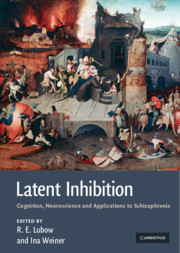Book contents
- Frontmatter
- Contents
- List of contributors
- Preface
- 1 A short history of latent inhibition research
- Current topics in latent inhibition research
- 2 Latent inhibition and extinction: their signature phenomena and the role of prediction error
- 3 Inter-stage context and time as determinants of latent inhibition
- 4 Latent inhibition: acquisition or performance deficit?
- 5 Latent inhibition and learned irrelevance in human contingency learning
- 6 Associative and nonassociative processes in latent inhibition: an elaboration of the Pearce–Hall model
- 7 From latent inhibition to retrospective revaluation: an attentional-associative model
- 8 Latent inhibition and habituation: evaluation of an associative analysis
- 9 Latent inhibition and creativity
- 10 The phylogenetic distribution of latent inhibition
- 11 The genetics of latent inhibition: studies of inbred and mutant mice
- 12 A comparison of mechanisms underlying the CS–US association and the CS–nothing association
- 13 The pharmacology of latent inhibition and its relevance to schizophrenia
- 14 Parahippocampal region–dopaminergic neuron relationships in latent inhibition
- 15 Latent inhibition and other salience modulation effects: same neural substrates?
- 16 What the brain teaches us about latent inhibition (LI): the neural substrates of the expression and prevention of LI
- 17 Latent inhibition in schizophrenia and schizotypy: a review of the empirical literature
- 18 A cautionary note about latent inhibition in schizophrenia: are we ignoring relevant information?
- 19 Latent inhibition as a function of anxiety and stress: implications for schizophrenia
- 20 Nicotinic modulation of attentional deficits in schizophrenia
- 21 Latent inhibition and schizophrenia: the ins and outs of context
- Summary and conclusions
- Index
- References
20 - Nicotinic modulation of attentional deficits in schizophrenia
from Current topics in latent inhibition research
Published online by Cambridge University Press: 04 August 2010
- Frontmatter
- Contents
- List of contributors
- Preface
- 1 A short history of latent inhibition research
- Current topics in latent inhibition research
- 2 Latent inhibition and extinction: their signature phenomena and the role of prediction error
- 3 Inter-stage context and time as determinants of latent inhibition
- 4 Latent inhibition: acquisition or performance deficit?
- 5 Latent inhibition and learned irrelevance in human contingency learning
- 6 Associative and nonassociative processes in latent inhibition: an elaboration of the Pearce–Hall model
- 7 From latent inhibition to retrospective revaluation: an attentional-associative model
- 8 Latent inhibition and habituation: evaluation of an associative analysis
- 9 Latent inhibition and creativity
- 10 The phylogenetic distribution of latent inhibition
- 11 The genetics of latent inhibition: studies of inbred and mutant mice
- 12 A comparison of mechanisms underlying the CS–US association and the CS–nothing association
- 13 The pharmacology of latent inhibition and its relevance to schizophrenia
- 14 Parahippocampal region–dopaminergic neuron relationships in latent inhibition
- 15 Latent inhibition and other salience modulation effects: same neural substrates?
- 16 What the brain teaches us about latent inhibition (LI): the neural substrates of the expression and prevention of LI
- 17 Latent inhibition in schizophrenia and schizotypy: a review of the empirical literature
- 18 A cautionary note about latent inhibition in schizophrenia: are we ignoring relevant information?
- 19 Latent inhibition as a function of anxiety and stress: implications for schizophrenia
- 20 Nicotinic modulation of attentional deficits in schizophrenia
- 21 Latent inhibition and schizophrenia: the ins and outs of context
- Summary and conclusions
- Index
- References
Summary
An introduction: nicotine, schizophrenia, and tobacco use
The purpose of this chapter is to review the role of nicotine in the modulation of attention, with particular application to the latent inhibition model of schizophrenia. Nicotine is the primary psychoactive chemical in tobacco. It is addictive and promotes continued tobacco use. According to the Centers for Disease Control and Prevention, the adverse health effects from cigarette smoking account for an estimated 438,000 deaths, or nearly 1 of every 5 deaths, each year in the United States – more than all deaths from human immunodeficiency virus (HIV), illegal drug use, alcohol use, motor vehicle injuries, suicides, and murders combined. The current estimate of cigarette smoking among adults in the United States is 20.8%; however, people with mental illness are much more likely to smoke, and consume a disproportionately large number of cigarettes (Goff, Sullivan, McEvoy et al., 2005; Grant, Hasin, Chou et al., 2004; Lasser, Boyd, Woolhander et al., 2000).
Schizophrenia is a cognitive disorder characterized by hallucinations and disturbances in memory, attention, and executive function. It is also characterized by an extremely high prevalence of smoking. Reliable estimates indicate that approximately 85–90% of schizophrenics smoke cigarettes (Hughes, Hatsukami, Mitchell, & Dahlgren, 1986). The co-morbidity between schizophrenia and nicotine addiction is striking and suggests that there may be common mechanisms in the pathways that lead to these diseases.
- Type
- Chapter
- Information
- Latent InhibitionCognition, Neuroscience and Applications to Schizophrenia, pp. 477 - 499Publisher: Cambridge University PressPrint publication year: 2010



